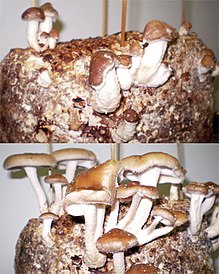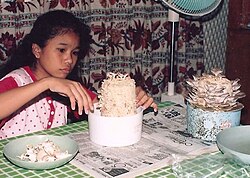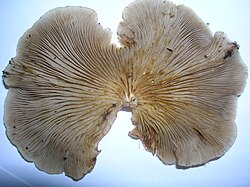The word is also commonly used to refer to the practice of cultivating fungi by leafcutter ants, termites, ambrosia beetles, and marsh periwinkles.
Introduction
Mushrooms are not plants, and require different conditions for optimal growth. Plants develop through photosynthesis, a process that converts atmospheric carbon dioxide into carbohydrates, especially cellulose. While sunlight provides an energy source for plants, mushrooms derive all of their energy and growth materials from their growth medium, through biochemical decomposition processes. This does not mean that light is an irrelevant requirement, since some fungi use light as a signal for fruiting. However, all the materials for growth must already be present in the growth medium. Mushrooms grow well at relative humidity levels of around 95–100%, and substrate moisture levels of 50 to 75%.
Instead of seeds, mushrooms reproduce asexually through spores. Spores can be contaminated with airborne microorganisms, which will interfere with mushroom growth and prevent a healthy crop.
Mycelium,
or actively growing mushroom culture, is placed on a substrate—usually
sterilized grains such as rye or millet—and induced to grow into those
grains. This is called inoculation. Inoculated grains (or plugs)
are referred to as spawn. Spores are another inoculation option, but
are less developed than established mycelium. Since they are also
contaminated easily, they are only manipulated in laboratory conditions
with a laminar flow cabinet.
Techniques
All
mushroom growing techniques require the correct combination of
humidity, temperature, substrate (growth medium) and inoculum (spawn or
starter culture). Wild harvests, outdoor log inoculation and indoor
trays all provide these elements.
Outdoor logs
Cultivated shiitake mushrooms
Mushrooms can be grown on logs placed outdoors in stacks or piles, as has been done for hundreds of years.
Sterilization is not performed in this method. Since production may be
unpredictable and seasonal, less than 5% of commercially sold mushrooms
are produced this way.
Here, tree logs are inoculated with spawn, then allowed to grow as they
would in wild conditions. Fruiting, or pinning, is triggered by
seasonal changes, or by briefly soaking the logs in cool water. Shiitake and oyster mushrooms
have traditionally been produced using the outdoor log technique,
although controlled techniques such as indoor tray growing or artificial
logs made of compressed substrate have been substituted.
Shiitake mushrooms grown under a forested canopy are considered non-timber forest products. In the Northeast
shiitake mushrooms can be cultivated on a variety of hardwood logs
including oak, American beech, sugar maple and hophornbeam. Softwood
should not be used to cultivate shiitake mushrooms.
The resin of softwoods will oftentimes inhibit the growth of the
shiitake mushroom making it impractical as a growing substrate.
In order to produce shiitake mushrooms, 1 metre (3 foot) hardwood
logs with a diameter ranging between 10–15 cm (4–6 in) are inoculated
with the mycelium of the shiitake fungus. Inoculation is completed by
drilling holes in hardwood logs, filling the holes with cultured
shiitake mycelium or inoculum, and then sealing the filled holes with
hot wax. After inoculation, the logs are placed under the closed canopy
of a coniferous stand and are left to incubate for 12 to 15 months. Once
incubation is complete, the logs are soaked in water for 24 hours. 7 to
10 days after soaking, shiitake mushrooms will begin to fruit and can
be harvested once fully ripe.
Indoor trays
Indoor
growing provides the ability to tightly regulate light, temperature and
humidity while excluding contaminants and pests. This allows consistent
production, regulated by spawning cycles. This is typically accomplished in windowless, purpose-built buildings, for large-scale commercial production.
Indoor tray growing is the most common commercial technique,
followed by containerized growing. The tray technique provides the
advantages of scalability and easier harvesting. Unlike wild harvests,
indoor techniques provide tight control over growing substrate
composition and growing conditions. Indoor harvests are much more
predictable.
According to Daniel Royse and Robert Beelman,
"[Indoor] Mushroom farming consists of six steps, and although the
divisions are somewhat arbitrary, these steps identify what is needed to
form a production system. The six steps are phase I composting, phase
II fertilizing, spawning, casing, pinning, and cropping."
Six phases of mushroom cultivation
| Phase | Time span | Temperature | Process(procedure) |
|---|---|---|---|
| 1. Phase I composting | 6–14 days |
|
Regulate water and NH3 content through microbial action. Add fertilizer / additives |
| 2. Phase II composting or pasteurization | 7–18 days via composting method, ~2 hours for pasteurization (heat sterilization) |
|
Reduce number of potentially harmful microbes through further composting, or apply heat sterilization. Remove unwanted NH3. |
| 3. Spawning and growth | 14–21 days | 24 to 27 °C (75 to 80 °F); must be above 23 °C (74 °F); for rapid growth. Must be below 27 to 29 °C (80 to 85 °F) to avoid damaging mycelia | Add starter culture. Allow mycelium to grow through substrate and form a colony. Depends on substrate dimensions and composition. Finished when mycelium has propagated through entire substrate layer |
| 4. Casing | 13–20 days |
|
Promote the formation of primordia, or mushroom pins. Add a top covering or dressing to the colonized substrate. Fertilizing with nitrogen increases yields. Induces pinning |
| 5. Pinning | 18–21 days |
|
Earliest formation of recognizable mushrooms from mycelium. Adjusting temperature, humidity and CO2 will also affect the number of pins, and mushroom size |
| 6. Cropping | Repeated over 7- to 10-day cycles |
|
Harvest |
Complete sterilization is not always required or performed during
composting. In some cases, a pasteurization step is not included to
allow some beneficial microorganisms to remain in the growth substrate.
Specific time spans and temperatures required during stages 3–6
will vary respective to species and variety. Substrate composition and
the geometry of growth substrate will also affect the ideal times and
temperatures.
Pinning is the trickiest part for a mushroom grower, since a combination of carbon dioxide (CO2) concentration, temperature, light, and humidity triggers mushrooms towards fruiting. Up until the point when rhizomorphs
or mushroom "pins" appear, the mycelium is an amorphous mass spread
throughout the growth substrate, unrecognizable as a mushroom.
Carbon dioxide concentration becomes elevated during the
vegetative growth phase, when mycelium is sealed in a gas-resistant
plastic barrier or bag which traps gases produced by the growing
mycelium. To induce pinning, this barrier is opened or ruptured. CO2 concentration then decreases from about 0.08% to 0.04%, the ambient atmospheric level.
Indoor Oyster Mushroom farming
A merchant selling Oyster Mushrooms grown indoors.
Oyster mushroom
farming is rapidly expanding around many parts of the world. Increased
consciousness of its nutritional value and increased market demand is
making mushroom cultivation one of the most sought businesses among the
farming communities. Oyster mushroom is grown in substrate that
comprises sterilized wheat or paddy straw and does not require much
space compared to other crops. It’s per unit production and profit
extracted is comparatively higher than other crops.
Substrates
Mushroom production converts the raw natural ingredients into mushroom tissue, most notably the carbohydrate chitin.
An ideal substrate will contain enough nitrogen and carbohydrate for rapid mushroom growth. Common bulk substrates include several of the following ingredients:
- Wood chips or sawdust
- Mulched straw (usually wheat, but also rice and other straws)
- Strawbedded horse or poultry manure
- Corncobs
- Waste or recycled paper
- Coffee pulp or grounds
- Nut and seed hulls
- Cottonseed hulls
- Cocoa bean hulls
- Cottonseed meal
- Soybean meal
- Brewer's grain
- Ammonium nitrate
- Urea
Mushrooms metabolize complex carbohydrates in their substrate into glucose,
which is then transported through the mycelium as needed for growth and
energy. While it is used as a main energy source, its concentration in
the growth medium should not exceed 2%. For ideal fruiting, closer to 1%
is ideal.
Coffee grounds
One of the most sustainable ways of mushroom cultivation is using coffee grounds as a substrate. This process was pioneered by Prof. Chang Shuting
in the early 1990s while he worked at the Chinese University in Hong
Kong. Coffee ground are sterile, and rich in fibers. It is more
environmentally-friendly; as an estimated millions of kilos of coffee
waste disposed in landfill every day, which could be diverted into sustainable
food production. The spent substrate, after harvesting mushrooms, is
enriched in essential amino-acids, and therefore an ideal feed for
animals.
Pests and diseases
Parasitic insects, bacteria and other fungi all pose risks to indoor production. The sciarid fly or phorid fly may lay eggs in the growth medium, which hatch into maggots and damage developing mushrooms during all growth stages. Bacterial blotch caused by Pseudomonas bacteria or patches of Trichoderma
green mold also pose a risk during the fruiting stage. Pesticides and
sanitizing agents are available to use against these infestations. Biological controls for insect sciarid and phorid flies have also been proposed.
A epidemic of Trichoderma green mold significantly affected
mushroom production: "From 1994–96, crop losses in Pennsylvania ranged
from 30 to 100%".
Commercially cultivated fungi
Home cultivated shiitake developing over approximately 24 hours.
- Agaricus bisporus, also known as champignon and the button mushroom. This species also includes the portobello and crimini mushrooms.
- Clitocybe nuda, or blewit, is cultivated in Europe.
- Auricularia polytricha or Auricularia auricula-judae (Tree ear fungus), two closely related species of jelly fungi that are commonly used in Chinese cuisine.
- Flammulina velutipes, the "winter mushroom", also known as enokitake in Japan
- Hypsizygus tessulatus (also Hypsizygus marmoreus), called shimeji in Japanese, it is a common variety of mushroom available in most markets in Japan. Known as "Beech mushroom" in Europe.
- Lentinus edodes, also known as shiitake, oak mushroom. Lentinus edodes is largely produced in Japan, China and South Korea. Lentinus edodes accounts for 10% of world production of cultivated mushrooms. Common in Japan, China, Australia and North America.
- Pleurotus species are the second most important mushrooms in production in the world, accounting for 25% of total world production. Pleurotus
mushrooms are cultivated worldwide; China is the major producer.
Several species can be grown on carbonaceous matter such as straw or
newspaper. In the wild they are usually found growing on wood.
- Pleurotus citrinopileatus (golden oyster mushroom)
- Pleurotus cornucopiae (branched oyster mushroom)
- Pleurotus eryngii (king trumpet mushroom)
- Pleurotus ostreatus (oyster mushroom)
Harvesting Pleurotus ostreatus cultivated using spawns embedded in sawdust mixture placed in plastic containers
Details of the gill structure of the edible oyster mushroom Pleurotus ostreatus.
- Rhizopus oligosporus - the fungal starter culture used in the production of tempeh. In tempeh the mycelia of R. oligosporus are consumed.
- Sparassis crispa - recent developments have led to this being cultivated in California. It is cultivated on large scale in Korea and Japan.
- Tremella fuciformis (Snow fungus), another type of jelly fungus that is commonly used in Chinese cuisine.
- Tuber species, (the truffle), Truffles belong to the ascomycete grouping of fungi. The truffle fruitbodies develop underground in mycorrhizal association with certain trees e.g. oak, poplar, beech, and hazel. Being difficult to find, trained pigs or dogs are often used to sniff them out for easy harvesting.
- Tuber aestivum (Summer or St. Jean truffle)
- Tuber magnatum (Piemont white truffle)
- Tuber melanosporum (Périgord truffle)
- T.melanosporum x T.magnatum (Khanaqa truffle)
- Terfezia sp. (Desert truffle)
- Ustilago maydis (Corn smut), a fungal pathogen of the maize plants. Also called the Mexican truffle, although not a true truffle.
- Volvariella volvacea (the "Paddy straw mushroom.") Volvariella mushrooms account for 16% of total production of cultivated mushrooms in the world.
- Fusarium venenatum - the source for mycoprotein which is used in Quorn, a meat analogue.
Production regions in North America
Pennsylvania is the top-producing mushroom state in the United States, and celebrates September as "Mushroom Month".
The borough of Kennett Square is a historical and present leader in mushroom production. It currently leads production
of Agaricus-type mushrooms, followed by California, Florida and Michigan.
Other mushroom-producing states:
- East: Connecticut, Delaware, Florida, Maryland, New York, Pennsylvania, Tennessee, Maine, and Vermont
- Central: Illinois, Oklahoma, Texas, and Wisconsin
- West: California, Colorado, Montana, Oregon, Utah and Washington
Vancouver, British Columbia, also has a significant number of
producers – about 60 as of 1998 – mostly located in the lower Fraser
Valley.
Production in Europe
The
oyster mushroom cultivation lately is taking off in Europe. Many
entrepreneurs nowadays find it as a quite profitable business, a
start-up with a small investment and good profit. Italy with 785,000
tonnes and Netherlands with 307,000 tonnes are between the top ten
mushroom producing countries in the world. The world’s biggest producer
of mushroom spawn is also situated in France.
According to a research carried out on Production and Marketing of Mushrooms: Global and National Scenario Poland, Netherlands, Belgium, Lithuania are the major exporting mushrooms countries in Europe and countries like UK, Germany, France, Russia are considered to be the major importing countries.
Education and training
Oyster mushroom
cultivation is a sustainable business where different natural resources
can be used as a substrate. The number of people becoming interested in
this field is rapidly increasing. The possibility of creating a viable
business in urban environments by using coffee grounds is appealing for
many entrepreneurs.
Since mushroom cultivation is not a subject available at school,
most urban farmers learned it by doing. The time to master mushroom
cultivation is time consuming and costly in missed revenue. For this
reason there are numerous companies in Europe specialized in mushroom
cultivation that are offering training for entrepreneurs and organizing
events to build community and share knowledge. They also show the
potential positive impact of this business on the environment.
Courses about mushroom cultivation can be attended in many
countries around Europe. There is education available for growing
mushrooms on coffee grounds, more advanced training for larger scale farming, spawn production and lab work and growing facilities.
Events are organised with different intervals. The Mushroom
Learning Network gathers once a year in Europe. The International
Society for Mushroom Science gathers once every five year somewhere in
the world.





